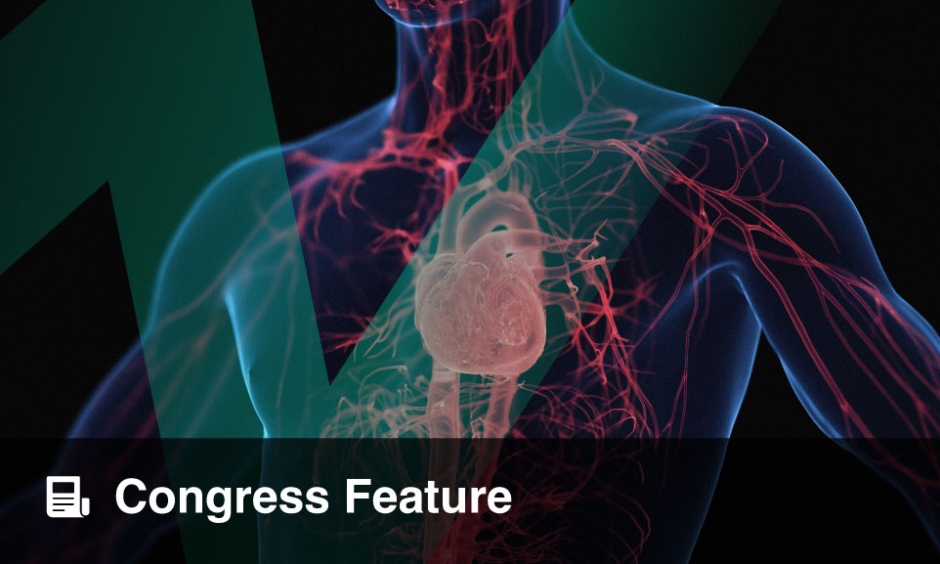Stephen Hoole | Consultant Cardiologist, Royal Papworth Hospital, Cambridge, UK; Affiliated Associate Professor, University of Cambridge, UK
Citation: EMJ Int Cardiol. 2024;12[1]:39-44. https://doi.org/10.33590/emjintcardiol/11000009.
![]()
What led you to pursue a career in interventional cardiology?
I was always fascinated by general medicine during my training as a medical student and house officer at the John Radcliffe Hospital in Oxford, UK. I particularly liked the immediacy of surgical treatments, with the prospect of ridding a patient of their symptoms, and sometimes curing them with the flash of a scalpel!
I was drawn to cardiology as a junior doctor because, as a medical specialty, it really led the field of evidence-based practice, with large randomised controlled trials that enabled clinicians to know what was best for their patients. The diagnostic tools, with 2D and 3D echo, CT coronary angiography, cardiac MRI, invasive angiography, imaging, and physiology, were also second to none, and together this made clinical decision-making comparatively simple, which was appealing.
Interventional cardiology was an exciting and growing field at the time of my training. With the emergence of drug-eluting stents, and the prospect of transcatheter valve intervention, a physician could do surgery, which appeared to me to be the best of both worlds. I began my interventional training at Papworth Hospital in Cambridge, UK, and completed a doctorate studying cardioprotection during percutaneous coronary intervention (PCI), which led to an ongoing research interest in this field. This was facilitated by a Clinical Lecturer position, also in Cambridge. Following a year-long interventional fellowship in Vancouver General Hospital, Canada, I was appointed as a National Health Service (NHS) Consultant in interventional cardiology at Papworth Hospital in 2011, with highly coveted, NHS-funded, dedicated research time.
Coronary artery stenting is an area of your expertise. What are the unique challenges associated with this surgical practice, and how do you improve stent safety and outcomes?
PCI has evolved in the four decades it has been available as a treatment. On the surface, the concept seems to be a simple one: a balloon, and sometimes a balloon-mounted stent, opens a blocked vessel and restores blood flow to heart muscle. But the safety and durability of the PCI result are its Achilles heel, and if not done optimally, results can be disappointing. Refinements in technique have addressed some of these issues. The preference for radial artery access has reduced bleeding complications, and is now mainstream; and the judicious use of intracoronary diagnostic physiology and imaging to guide lesion selection, adjunctive lesion modification before stenting, and post-stent optimisation in increasingly complex and calcified coronary artery disease, ensures the best long-term outcomes.
However, good technique addresses only part of the challenge. PCI-related myocardial infarction (MI) and reperfusion injury may be inadvertently caused by stent deployment, and is deleterious. Furthermore, following successful stenting, chest pain may persist due, in part, to coronary microcirculatory dysfunction. We have evaluated several cardioprotective strategies to improve myocardial resistance to ischaemia at the time of PCI, maintain microvascular integrity, and limit reperfusion injury, with mixed results. We recently successfully completed a pivotal safety trial, administering the anti-CD20 monoclonal antibody rituximab to reduce B-cells, which contribute to adverse remodelling, in patients with ST-elevation MI. This has led to an ongoing large, multinational, multicentre, randomised controlled trial, to hopefully establish the efficacy of this immunomodulatory strategy, to salvage myocardium in patients presenting with anterior ST-elevation MI.
The Royal Papworth is the only hospital in the UK which performs balloon pulmonary angioplasty (BPA). You are also the national interventional lead for the UK BPA service. Can you tell us more about this pioneering procedure, and its benefits for patients?
Chronic thromboembolic pulmonary hypertension (CTEPH) occurs when pulmonary emboli fail to spontaneously resorb after a period of anticoagulation, and instead form mesh-like narrowings, called ‘webs’, in the pulmonary arteries, leading to pulmonary hypertension and persistent breathlessness and fatigue. This may be treated by pulmonary endarterectomy (PEA), but 40% of patients with CTEPH are inoperable, due to either inaccessible subsegmental disease, or comorbidities that preclude surgery. Up until recently, these patients were only offered symptomatic relief with pulmonary vasodilator therapy, and their outlook was comparatively worse than those who had PEA. BPA offers a further treatment option for patients with inoperable CTEPH. The procedure leverages the techniques employed in PCI: a balloon is delivered over a guidewire and dilates a channel through the web, relieving the obstruction, and enabling improved pulmonary perfusion and gas exchange. The patients are awake during the procedure, and typically have three to four treatment sessions to achieve the best results.
We are currently the only UK centre offering this pioneering treatment, and we have comparable results with other leading international centres. Our patients demonstrably improve their pulmonary haemodynamic status, with reduced echocardiographic and biomarker evidence of right heart strain, improved functional status and quality of life, and prolonged survival, comparable to that of patients treated by PEA. Importantly, our BPA service has been extremely safe, with no major procedural-related complications or deaths since we started our service over 8 years ago. This attests to the skill of the whole team involved in the care of these complex patients.
You recently co-authored the paper ‘The Index of Microcirculatory Resistance After Primary Percutaneous Coronary Intervention: A Pooled Analysis of Individual Patient Data’. What were the key learning points from this article, and how do these findings contribute to the existing literature on microvascular dysfunction after PCI?
This was a collaborative paper, led by a team at Stanford University, California, USA, which pooled pressure-wire data assessing microcirculatory dysfunction at the time of primary PCI, from several international centres. We had initially collected our dataset to confirm that manual thrombectomy, the removal of a clot from an occluded coronary artery during an ST-elevation MI before stent deployment, contributed to, rather than prevented, procedure-related microembolic injury. The subsequent randomised controlled trials, demonstrating that routine manual thrombectomy did not improve clinical outcomes, were therefore somewhat expected.
The key take-home message of this paper, other than emphasising that we can achieve more by working together collaboratively, was to confirm, in a large cohort of patients with ST-elevation MI, that microcirculatory dysfunction measured at the time of primary PCI was an independent predictor of cardiac death at 5-year follow-up. Therefore, if we assess the index of microcirculatory resistance at the end of primary PCI, we can identify the highest-risk group of patients, who may benefit from additional cardioprotective therapies and monitoring. In addition, the trial justifies using the index of microcirculatory resistance as a surrogate endpoint for future cardioprotective trials, which are still needed to improve the outcome of patients with ST-elevation MI.
With over 150 peer-reviewed manuscripts to your name for your research in interventional cardiology, what do you believe to be the current gaps in the literature, and which topics merit greater attention?
Focusing on my own area of interest of coronary intervention, we still need to conquer reperfusion injury and microvascular dysfunction at the time of MI revascularisation. Both often limit the PCI therapeutic effect. It is astounding that almost half of the final infarct size is attributed to reperfusion injury caused by stenting the infarct-related artery. Interventional cardiologists will be only too aware of the phenomenon of technical success: an open artery, but ultimately a disappointing therapeutic failure, when a large, completed MI occurs despite our efforts.
To date, the randomised trials that have assessed treatments targeting reperfusion injury have been disappointingly negative, despite promising initial data, and have not been endorsed or adopted clinically. This may be due, in part, to trial design, and the difficulties of translational research in this field. But we must persevere to achieve reperfusion quality, to further reduce infarct size and improve the outcomes of patients presenting with acute MI. Furthermore, although we can quantitatively measure coronary microcirculatory dysfunction (CMD) invasively with pressure wire at the time of MI, and in stable coronary syndromes, and we know that CMD is widely prevalent in patients with chest pain, we lack specific therapies for CMD. Further trials are necessary to bridge this ‘therapeutic chasm’.
Finally, the iterative development of drug-eluting stents has probably reached its zenith, but despite this, there remains a small but significant year-on-year risk of coronary stent failure, even in those stents that have been implanted optimally. The concept of ‘leaving nothing behind’ remains an attractive one to many interventionists, including myself. Although the first foray into bioresorbable scaffolds ultimately led to failure, drug-eluting balloons and novel dissolvable stent platforms are still worth pursuing.
You are also a specialist and expert adviser to the Medicines and Healthcare products Regulatory Agency (MHRA), National Institute for Health and Care Excellence (NICE), and National Institute for Health and Care Research Health Technology Assessment (NIHR HTA) interventional device programmes. What is your main focus in these roles?
I act as an independent advisor to the MHRA and NIHR HTA, providing clinical assessments of new devices and technologies, and, in particular, reviewing the design of new device trials. I have an interest in innovation, and with the help of others, I have developed two new devices: one in clinical use, and another undergoing clinical trials. I have found the regulatory experience from ‘the other side’ illuminating. Regulatory diligence is vital, in order for the public to have confidence that it is safe and worthwhile to participate in a new device trial in the UK, and for the findings to ultimately be meaningful. I hope I have helped to ensure that only well-designed new device trials are funded and approved, so that promising new devices are robustly assessed, and those that work may be rapidly made available for clinical use.
I have also sat on two guideline committees as an expert and Chair for NICE. Both were a rich and rewarding experience, allowing time for a detailed review of a subject with constructive discussion between a broad range of experts, and formulating guidance that will have real impact, not only to the care of patients within the UK, but internationally, too.
How has the advent of new technologies impacted the field of interventional cardiology in recent years? Are there any innovations on the horizon that you think are particularly noteworthy?
Undoubtably, the big success story for the field of interventional cardiology has been the evolution of percutaneous valvular replacement and repair, and in particular, transcutaneous aortic valve implantation (TAVI). TAVI has been a revolutionary treatment for patients with aortic valve stenosis, with rapid recovery times, and good long-term outcomes enabling more patients to be treated. However, despite the hype of transcatheter edge-to-edge repair for mitral incompetence, this remains a palliative procedure in my view. The surgical Alfieri stitch repair, on which it is based, has all but disappeared from surgical practice, and innovative new solutions that deliver a functionally perfect percutaneous valve repair to the more complex mitral, and tricuspid, valves are a fertile ground for innovation.
In the coronary space, the old foe of coronary calcification has been dealt several blows with the iterative evolution of rotational atherectomy, as well as the development of orbital atherectomy, excimer laser coronary atherectomy, and intravascular lithotripsy. The latter, in particular, is the big success story due to its simplicity; any innovation that makes life easier for the operator, as well as improving outcomes for the patient, will achieve high market penetrance. The value of intracoronary imaging to guide calcium modification has also had a resurgence with the development of these tools, and improved user interface, which again makes life simpler, has been an important development.
There is still more to be done in the intracoronary diagnostic space to understand in vivo plaque biology, with new advances in automated vulnerable plaque detection software, and catheters that can detect trans-coronary biomarker gradients. In concert, these tools may soon provide further understanding to predict which coronary plaques are at risk of causing future clinical events. Then, the question will be: what do we have in the interventional toolbox to deal with such plaques? This will inevitably lead to yet more innovative solutions, and, as frequently occurs with innovation, perhaps the return of old treatments like resorbable stents. Similarly, another area of unmet need is coronary microvascular dysfunction, where we have the diagnostic capability, but lack specific treatments; this area is ripe for growth. Innovations, like coronary sinus reducer, are an exciting development, that may be of help here.
Finally, it would be remiss of me not to mention a complication of acute MI that I think we have not made any meaningful progress in addressing in the last two decades: cardiogenic shock. Despite developments in mechanical circulatory support, the outlook for patients with cardiogenic shock remains bleak. Perhaps prevention, with better myocardial salvage at the time of initial acute MI presentation, will prove to be better than, and obviate the need for, a cure. Hopefully, effective adjunctive therapies to minimise reperfusion injury, associated microcirculatory dysfunction, and adverse remodelling are on the horizon, and will make cardiogenic shock a rarity in the future.
Since your appointment to Consultant Interventional Cardiologist at Royal Papworth, what has been your proudest achievement?
It is always gratifying to see interventional trainees and fellows, who I have mentored and taught, achieve success in their careers. I have been the interventional cardiology fellowship programme director in Cambridge for more than 10 years, and over that time, we have had over a dozen UK and international fellows join us for 12 months, which has brought mutual benefits. I have also been lucky to collaboratively supervise over 10 talented research fellows studying for a doctorate, who have immersed themselves in research projects from my group, and presented and published their work to acclaim; we recently had one fellow presented with a Young Investigator Award at the European Society of Cardiology (ESC) meeting, which was a particularly proud moment. I still get a buzz from presenting and publishing new data, and contributing to the growth in knowledge of the field of cardiology, and I don’t see that ever changing.
I also get immense satisfaction from developing new services in Cambridge to improve the outlook of patients that we serve. New services and innovation enable cutting-edge, high-quality care delivery, and both are often a direct spin-off from research. This link advocates why we need more NHS clinicians participating in research. I have been lucky enough to see and take opportunities to successfully initiate or develop, and lead five local interventional services during my career so far: chronic total occlusion in 2013, BPA in 2015, TAVI in 2017, coronary sinus reducers in 2021, and excimer laser coronary atherectomy in 2023. Bringing these services online has acted as a series of career milestones that have kept me motivated, interested, and engaged clinically. Coronary reactivity testing is on the horizon for 2024, with acute pulmonary embolism and possibly stroke intervention to follow, if turf wars can be resolved amicably!







